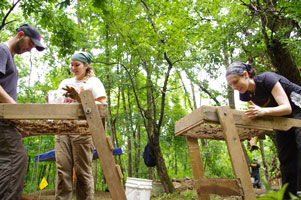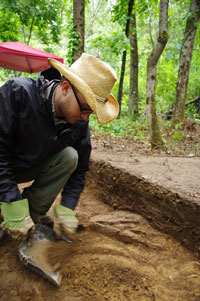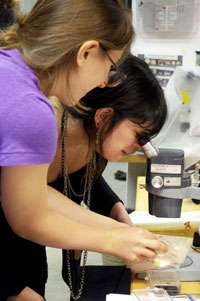The Nipmuc House
By Jennifer Poulsen
Photos by Heather Law Pezzarossi

This year’s Massachusetts Archaeology Month poster takes a closer look at an 18th century Nipmuc house foundation in Grafton, Massachusetts. This house is the Sarah Boston Farmstead Site, part of the Hassanamesit Woods Project. Excavation has been ongoing at this site since 2003. Led by Dr. Stephen Mrozowski, the project is a collaboration between the Fiske Center for Archaeological Research, the Nipmuc Nation, and the Town of Grafton.
While Native Americans have occupied this site for the last 4,000 years, it is rare for archaeologists to identify Native houses in New England from as recently as the 18th and 19th centuries. The Sarah Boston Farmstead was ultimately demolished after the hurricane of 1938, but by using historic documents and scientific techniques, archaeologists are able to learn more about Sarah Boston, the charismatic woman who owned this land.

Archaeologists used Ground Penetrating Radar (GPR) to send a signal into the dirt and “see” what lay beneath. This helped to identify the location of the stone foundation of the house. Surveying equipment was used to create digital maps in a Geographic Information System (GIS).
Careful excavation of layers of dirt helped uncover the house foundation, the house’s cooking area, and a drain. As they excavated, archaeologists sifted the dirt in a fine mesh and recorded what artifacts they found and where they came from. Artifacts from the site included heavy iron kettles, animal bones, buttons, plates, drinking glasses, cutlery, and more. Conservation of iron artifacts helped to identify objects that would have otherwise been too rusted to recognize. Some special artifacts also support historic documents, showing that Sarah Boston was a skilled basket maker who sold her wares across New England.

Archaeologists also use special scientific tests on the soil to learn more about the past. Geo-chemical tests on phosphate levels in the soil were used to help look for the location of the barn (livestock create a lot of phosphate in their manure!). Soil was also analyzed by taking samples to look at microscopic pollen. Looking at the pollen record helps archaeologists better understand the historical landscape and changes to vegetation at the site. Finally, soil from within the house was examined for larger plant remains, called macrobotanical analysis. This is used to find pieces of charcoal and plants that Sarah Boston may have used or eaten in her house.
Work at Hassanamesit Woods is still ongoing, and archaeologists are learning more every year. For additional photos and updates on the work at this site, please visit: blogs.umb.edu/fiskecenter/category/hass-woods-grafton-ma/